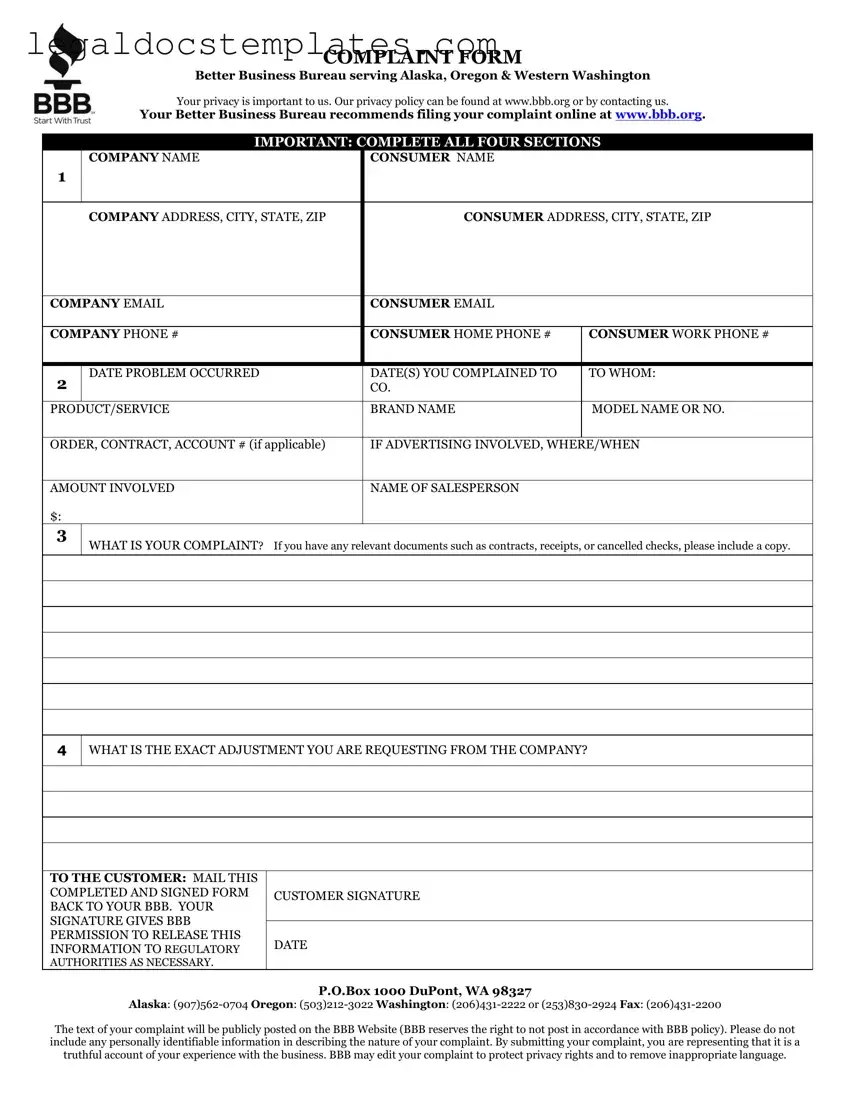The Federal Trade Commission (FTC) Complaint Form shares similarities with the BBB Complaint form, as both endeavor to assist consumers in filing grievances against businesses. These forms provide a structured platform for reporting issues related to products, services, or practices that might be considered unfair, deceptive, or unethical. By submitting complaints, consumers contribute to the monitoring and regulation of business conduct, thus protecting future customers from potential misconduct.
Consumer Financial Protection Bureau (CFPB) Complaint Form operates on a parallel track to the BBB Complaint Form by focusing specifically on financial products and services issues, such as problems with banks, credit cards, loans, and other financial services. Both forms gather detailed information about the complaint, aiming to resolve the dispute and enforce compliance with consumer finance laws, ensuring fair treatment for consumers.
The Attorney General Consumer Complaint Form, found in many state websites, is akin to the BBB Complaint Form in its goal to protect consumers from fraudulent, deceptive, and unfair business practices. By filing a complaint with the Attorney General's office, consumers can seek help in resolving disputes and may contribute to broader investigatory actions against companies violating consumer protection laws.
The Health Insurance Complaint Form used by state departments of insurance resembles the BBB Complaint Form in its consumer advocacy role, but it narrows its focus to disputes between consumers and their health insurance providers. These forms help address issues such as denial of coverage, billing disputes, and service complaints, ensuring that insurers adhere to fair practices and regulatory standards.
The Better Business Bureau Auto Line Complaint Form specifically targets automobile-related disputes, making it a specialized counterpart to the generic BBB Complaint Form. It helps consumers address issues with vehicle warranties, defects, and repairs through a structured complaint resolution process, often involving mediation or arbitration to settle disputes without resorting to legal action.
The Online Dispute Resolution (ODR) platforms, like eBay's resolution center or PayPal's dispute system, share the fundamental objective of resolving disputes through a formalized process. While focused primarily on transactions and conflicts arising within their specific online platforms, these systems akin to the BBB Complaint Form, offer a way for consumers and sellers to resolve issues directly under the platform's guidelines and support.
The Small Claims Court Filing Form stands as another avenue for dispute resolution, allowing individuals to formally present their cases against businesses or individuals in a courtroom setting for claims under a certain monetary threshold. Similar to the BBB Complaint Form, it empowers consumers to seek justice, often without the need for an attorney, for various grievances including contractual disputes and property damage.
The Consumer Product Safety Commission (CPSC) Consumer Complaint Form is dedicated to addressing hazards posed by defective or unsafe consumer products. Like the BBB Complaint Form, it collects complaints to analyze and address safety issues, potentially leading to recalls, warnings, or enforcement actions to prevent harm and uphold safety standards.
The Tenant Complaint Forms, available through local housing authorities or tenant associations, facilitate reports of unacceptable living conditions, landlord disputes, and other rental property issues. They mirror the BBB Complaint Form in their role to mediate between parties and advocate for resolution, but within the housing and rental market context.
The Air Travel Consumer Report Form by the Department of Transportation (DOT) allows passengers to report problems directly related to air travel such as mishandled baggage, issues with refunds, overbooking, and disability access concerns. By documenting and addressing these complaints, similar to the BBB Complaint Form, it aims to enhance the overall quality of air travel services and enforce airline compliance with federal regulations.

